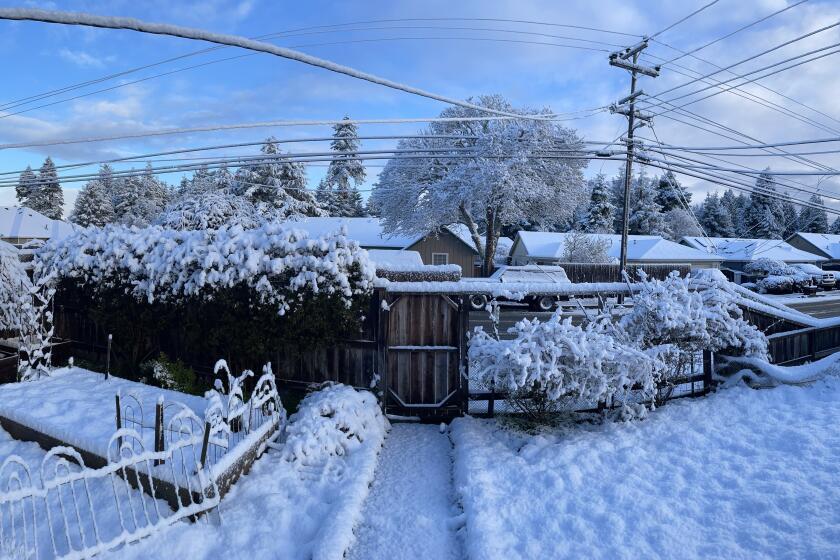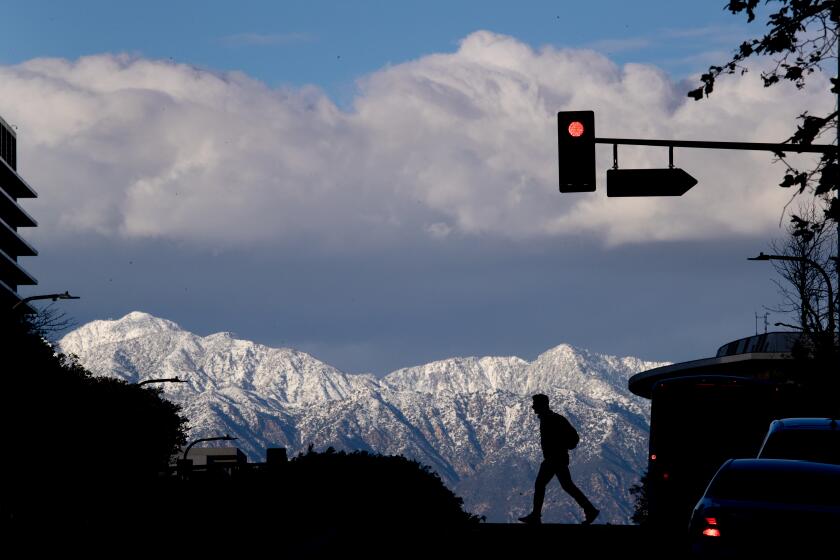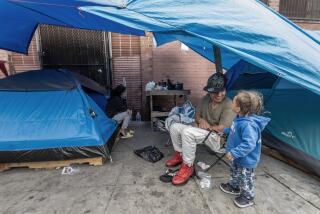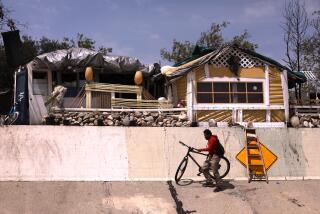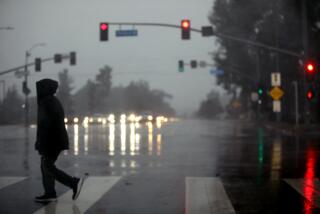Southern California races to shelter homeless people as frigid storm bears down
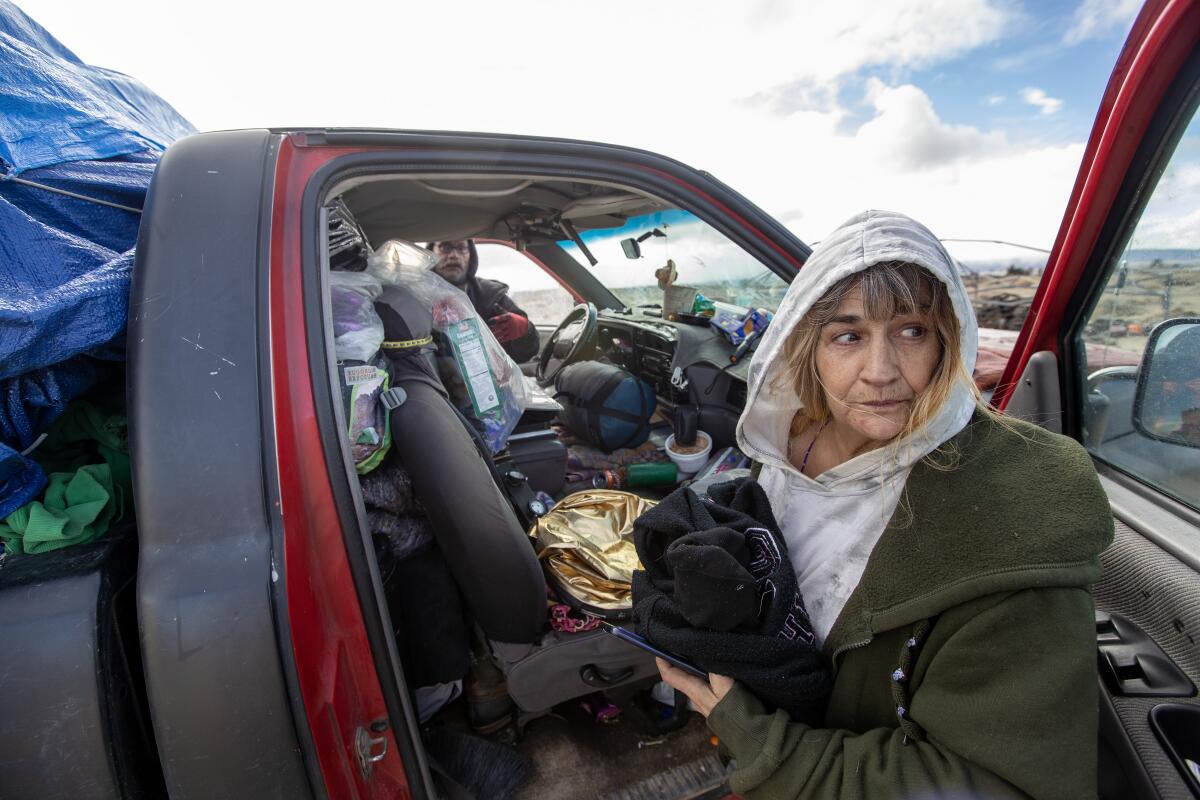
Homeless services providers were struggling with shortages of shelter space Thursday as a rare winter storm raised the danger level for thousands of people living outdoors, with a forecast of three days of rain, freezing temperatures, blizzard-strength wind and low-elevation snow.
As the monster storm approaches, officials say some parts of the county won’t have enough beds for people living on the street after the season’s earlier rainstorms and enduring cold put a strain on the regional shelter system.
“It is not enough to meet demand,” Molly Rysman, chief programs officer with the Los Angeles Homeless Services Authority, said in an interview. “I was out there with our team and it was a struggle to find a bed for folks.”
Besides about 11,000 year-round shelter beds, LAHSA opens an additional 270 seasonal beds from November through March.
Last year, the agency cut back its winter program from 11 to five shelters in a shift to a voucher program that allows outreach workers to place people in motel rooms.
There are 27 hotels enrolled in that program, officials said. The program was budgeted for 142 beds in the city of Los Angeles and 367 in the remainder of the county. Outreach workers have been supplementing those with vouchers from other programs.
Because of earlier storms, the program has been heavily used, Rysman said.
“We’ve had a lot of activations essentially since the end of December,” she said. “It’s been almost constant.”
The risk of hypothermia was especially acute in the Antelope Valley, where flurries of snow fell Thursday and freezing temperatures were expected to be accompanied by more snow through Saturday.
Already dumping snow in Northern California, the storm is set to intensify as it moves to Southern California, bringing blizzard warnings to the mountains.
Wednesday was a brutal night for Terry Stephens, 66, who held herself up with two walking canes outside the trailer in Palmdale she shares with her son and his girlfriend.
“It was frigid, your bones ache and you can’t get warm,” she said. “I had three blankets on me last night and I was still freezing. Nothing helped.”
Stephens was one of about a dozen people outreach workers with LAHSA were desperately trying to place in Palmdale-area hotels ahead of Thursday’s storm.
She said she didn’t hesitate to take up the offer. She has metal plates in her back and neck that make it harder for her to stay warm. On Thursday she stood with two layers of sweaters and a scarf wrapped around her head as LAHSA workers called hotels to make sure there was an opening. Fortunately, there was.
Around 10 a.m., Stephens arrived at a Motel 6, smiling as she used the canes to help her walk to the ground-floor room.
LAHSA outreach worker Audrey Rubio used the hotel key card to open the door and helped Stephens in.
“It’s so warm,” Stephens said.
She sat at the edge of the bed and hugged Rubio.
“You’ve got my number?” Rubio asked.
“I got your number,” Stephens said.
Rubio said she felt good knowing Stephens was inside a warm room. “She’s 66 and it hurts me to see her living in the streets,” Rubio said. “I have a mother and I wouldn’t want her to live like that.”
Three more successes came when Rubio tracked down Tony Chavez, 59, and his partner, Crystal Jones, 63, who were living in a 1997 Dodge Ram, and Raul Lopez, 62, who was placing a tarp on his white Chevy Tahoe to prepare for the approaching storm. All said they were grateful for the chance to go to a shelter.
Last year, Lopez said, he underestimated the cold weather in the desert and suffered hypothermia, losing a toe after it froze.
“I’m so tired of the desert,” he said. “I used to own a home, I used to work and coach kids’ football and baseball. I have three boys and two daughters.”
Arriving at the motel, he said he planned to shower and then watch some television before washing his clothes.
His room is paid through Sunday, but it may be extended amid a second storm approaching the region.
A frigid storm moving in from the Gulf of Alaska will dump several feet of snow on Northern California mountains over the next few days, bringing whiteout conditions and dangerous wind chills.
Rubio said she had found hotel rooms for six of her clients. Knowing they will be sheltered made her feel less worried. “They’re alive and well.”
In anticipation of the storms, Los Angeles Mission, a homeless shelter on skid row, helped open a warming station equipped with jackets, gloves and heaters, said Pastor Troy Vaughn, president and chief executive.
The mission placed propane heating towers around skid row restrooms it operates and was distributing tents and pallet systems so those who don’t come indoors can be off the ground, Vaughn said.
“We’re just trying to be creative as much as we can,” he said.
As of Wednesday morning, there were only five to seven available beds at the mission, which can typically house around 400 people. Vaughn said he and his staff were trying to make about 36 beds available at the Joshua House hotel across the street.
He said one of the biggest barriers for people coming to the shelters is not having a place for their belongings.
“I think we need a response, much like we had during COVID, which is this massive FEMA-like response and understanding that it needs to be a citywide and countywide response, much like they do in New York,” he said. “When it gets to a certain temperature, it’s a mandate for people to come in, because at that point it’s a health crisis. We need to have something like that.”
Scenes from across Southern California, where a powerful winter storm dumped heaps of snow and record-setting rain.
Facing unusual demand, High Desert Homeless Services in Victorville was shuffling clients between its two shelters to make room for those trying to get out of the cold, said Executive Director Jimmy Waldron.
As of Thursday afternoon, there were 81 people at the 90-bed “low-barrier” interim shelter, which has no sobriety requirement.
“Usually during the cold months, we have between 70 to 76,” Waldron said. He hoped more people come in as the weather worsens.
“We haven’t gotten any snow yet. It’s cold, but it seems to be going around us. The worst is supposed to be tonight,” he said. “There are people out there doing code enforcements at the encampments, so hopefully we’ll see more come in.”
There were spaces available at the family shelter, but the barriers there are high: Drugs and alcohol are prohibited, and there are no accommodations for pets.
“The barriers are higher here,” said Jennifer K., a residential coordinator who gave only her last initial. “If they’ve been diagnosed with depression or schizophrenia, they have to be stable and on medication for at least three weeks.”
To free beds at the interim shelter, clients who pass drug tests are being moved to the family shelter.
During inclement weather, homeless people may struggle to meet the requirements of getting into the family shelter, such as not having drugs in their system during intake.
Pets are another impediment.
“People are not gonna leave their animals,” Jennifer K. said. “The great thing about the interim shelter is they do have a place for their dogs.”
In Ventura County and along the Central Coast, teams have been engaging with populations residing in riverbeds.
“Flooding there is just deadly,” said Joann Gillett, director of communications for Rescue Mission Alliance, which offers emergency shelter in Oxnard, Northridge and Victorville.
“There’s often swift-water rescues. There’s death due to drowning, and so at our Ventura County location, where we have emergency shelter, we allow more people to stay overnight during bad weather.”
Outreach teams, which go out every day, were operating with more urgency leading up to the storms.
“We’re always out there in river bottoms, trying to let people know about our services,” Gillett said. “We serve two meals a day, every day. We encourage people to come and see us and start to forge those relationships to hopefully build that trust and provide an opportunity for them to walk away from this.”
At the alliance’s Ventura County Rescue Mission, there were only nine of 63 total beds available for the men and women’s emergency shelter as of Thursday morning, according to Gillett. Because of the weather, the shelter is considering adding 20 beds to the men’s shelter.
River outreach goes on year-round in Los Angeles but intensifies when severe weather is forecast, said Ahmad Chapman, director of communications for the homeless authority.
“Outreach teams from LAHSA and the county go into the areas around creeks and rivers to inform people that severe weather is coming and to seek higher ground,” Chapman said. “If interim housing resources are available, the teams will offer them along with a ride.”
Rysman, the homeless authority’s chief programs officer, said the Westside is a problem area for the agency.
“That is where it’s been the hardest to open interim housing programs, and that’s where we find there’s the greatest demand in terms of not having enough beds for the many people who want them,” she said.
Rysman said the situation underscores the pressure the shelter system faces amid climate change.
“We have not figured out how to secure the resources to address all the extreme weather conditions that are now part of our regular work, and it’s really year-round.”
But Orlando Ward, executive director of external affairs at Volunteers of America, which operates more than a dozen shelters across Southern California, doesn’t see climate as the problem.
“The weather should not be the reason for us to respond with any type of increased urgency,” Ward said. “The urgency needs to be there at 75 degrees and mild.”
More to Read
Sign up for Essential California
The most important California stories and recommendations in your inbox every morning.
You may occasionally receive promotional content from the Los Angeles Times.
